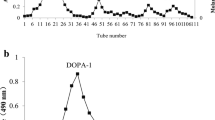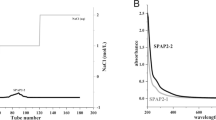Abstract
WGEW, an α(1-4) linked glucan with an α(1-4) linked branch attached to C-6, was isolated from the rhizoma of Gastrodia elata Bl. WSS25, a sulfated derivative of WGEW, was reported to inhibit angiogenesis by disrupting BMP2/Smad/Id1 signaling pathway. However, the structure-activity relationship (SAR) for WSS25 is not known. To study the SAR, seven sulfated saccharides derived from WGEW degradation products, six sulfated polysaccharides with varying degrees of substitution, and four aminopropylated, carboxymethylated, phosphorylated, and acetylated derivatives of WGEW were prepared. A sulfated, unbranched product of polysaccharide was also obtained. The structural features of these derivatives were characterized by infrared spectroscopy and nuclear magnetic resonance spectroscopy. An HMEC-1 cell tube formation assay was employed to measure the antiangiogenic effect of the derivatives. The results indicated that only sulfated polysaccharides with molecular weights of more than 41,000 Da could inhibit HMEC-1 cell tube formation. The inhibition effect was dependent on the presence of a sulfate group, since the tube formation was not blocked by aminopropylated, carboxymethylated, phosphorylated, or acetylated WGEW. A higher degree of sulfate substitution on the polysaccharide led to a stronger inhibitory effect, and the degree of sulfate substitution between 0.173 and 0.194 was found to be optimal. Interestingly, the WGEW side chain was not required for anti-tube formation activity. All these preliminary results may provide a clue for further modification of the core structure of WSS25 to discover polysaccharide derivatives as novel anti-angiogenic inhibitors.







Similar content being viewed by others
Abbreviations
- bFGF:
-
Basic fibroblast growth factor
- BMP2:
-
Bone morphogenic protein 2
- DMSO:
-
Dimethyl sulfoxide
- DS:
-
Degree of substitution
- FBS:
-
Fetal bovine serum
- FGF2:
-
Fibroblast growth factor 2
- GC-MS:
-
Gas chromatography–mass spectrometry
- HMEC-1:
-
Human microvascular endothelial cells
- HPGPC:
-
High performance gel permeation chromatography
- HS:
-
Heparan sulfate
- Id1:
-
Inhibitor of DNA binding 1
- IR:
-
Infrared
- MTT:
-
3-(4,5-dimethylthiazol-2-yl)-2,5-diphenyltetrazolium bromide
- MW :
-
Molecular weight
- NMR:
-
Nuclear magnetic resonance
- QCM:
-
Quartz crystal microbalance
- SAR:
-
Structure-activity relationship
- TFA:
-
Trifluoroacetic acid
- VEGF:
-
Vascular endothelial growth factor
References
Matter, A.: Tumor angiogenesis as a therapeutic target. Drug Discov. Today. 6, 1005–1024 (2001)
Raica, M., Cimpean, A.M., Ribatti, D.: Angiogenesis in pre-malignant conditions. Eur. J. Cancer 45, 1924–1934 (2009)
Folkman, J.: Role of angiogenesis in tumor growth and metastasis. Semin. Oncol. 29, 15–18 (2002)
Folkman, J.: Angiogenesis: an organizing principle for drug discovery? Nat. Rev. Drug Discov. 6, 273–286 (2007)
Carmeliet, P., Jain, R.K.: Molecular mechanisms and clinical applications of angiogenesis. Nature 473, 298–307 (2011)
Spillmann, D.: Heparan sulfate: Anchor for viral intruders? Biochimie 83, 811–817 (2001)
Fujita, K., Takechi, E., Sakamoto, N., Sumiyoshi, N., Izumi, S., Miyamoto, T., Matsuura, S., Tsurugaya, T., Akasaka, K., et al.: HpSulf, a heparan sulfate 6-O-endosulfatase, is involved in the regulation of VEGF signaling during sea urchin development. Mech. Develop. 127, 235–245 (2010)
Forsten-Williams, K., Chua, C.C., Nugent, M.A.: The kinetics of FGF-2 binding to heparan sulfate proteoglycans and MAP kinase signaling. J. Theor. Biol. 233, 483–499 (2005)
Nyberg, K., Ekblad, M., Bergstrom, T., Freeman, C., Parish, C.R., Ferro, V., Trybala, E.: The low molecular weight heparan sulfate-mimetic, PI-88, inhibits cell-to-cell spread of herpes simplex virus. Antiviral. Res. 63, 15–24 (2004)
Kasbauer, C.W., Paper, D.H., Franz, G.: Sulfated beta-(1–>4)-galacto-oligosaccharides and their effect on angiogenesis. Carbohydr. Res. 330, 427–430 (2001)
Casu, B., Naggi, A., Torri, G.: Heparin-derived heparan sulfate mimics to modulate heparan sulfate-protein interaction in inflammation and cancer. Matrix Biol. 29, 442–452 (2010)
Zhang, W., Swanson, R., Xiong, Y., Richard, B., Olson, S.T.: Antiangiogenic antithrombin blocks the heparan sulfate-dependent binding of proangiogenic growth factors to their endothelial cell receptors: evidence for differential binding of antiangiogenic and anticoagulant forms of antithrombin to proangiogenic heparan sulfate domains. J. Biol. Chem. 281, 37302–37310 (2006)
Qiu, H., Yang, B., Pei, Z.C., Zhang, Z., Ding, K.: WSS25 inhibits growth of xenografted hepatocellular cancer cells in nude mice by disrupting angiogenesis via blocking bone morphogenetic protein (BMP)/Smad/Id1 signaling. J. Biol. Chem. 285, 32638–32646 (2010)
Qiu, H., Tang, W., Tong, X., Ding, K., Zuo, J.: Structure elucidation and sulfated derivatives preparation of two alpha-D-glucans from Gastrodia elata Bl. and their anti-dengue virus bioactivities. Carbohydr. Res 342, 2230–2236 (2007)
Inoue, K., Kawamoto, K., Nakajima, H., Kohno, M., Kadoya, S., Mizuno, D.: Chemical modification and anti-tumor activity of a D-Manno-D-Glucan from Microellobosporia-Grisea. Carbohydr. Res. 115, 199–208 (1983)
Bao, X., Duan, J., Fang, X., Fang, J.: Chemical modifications of the (1– > 3)-alpha-D-glucan from spores of Ganoderma lucidum and investigation of their physicochemical properties and immunological activity. Carbohydr. Res. 336, 127–140 (2001)
Suflet, D.M., Chitanu, G.C., Popa, V.I.: Phosphorylation of polysaccharides: New results on synthesis and characterisation of phosphorylated cellulose. React. Funct. Polym. 66, 1240–1249 (2006)
Ueno, Y., Okamoto, Y., Yamauchi, R., Kato, K.: An anti-tumor activity of the alkali-soluble polysaccharide (and its derivatives) obtained from the Sclerotia of Grifora-Umbellata (Fr) Pilat. Carbohydr. Res. 101, 160–167 (1982)
Wang, L., Xie, B.J., Shi, J., Xue, S., Deng, Q.C., Wei, Y., Tian, B.Q.: Physicochemical properties and structure of starches from Chinese rice cultivars. Food Hydrocolloid 24, 208–216 (2010)
Needs, P.W., Selvendran, R.R.: Avoiding oxidative-degradation during sodium-hydroxide methyl iodide-mediated carbohydrate methylation in dimethyl-sulfoxide. Carbohydr. Res. 245, 1–10 (1993)
Xu, Y., Dong, Q., Qiu, H., Cong, R., Ding, K.: Structural characterization of an arabinogalactan from Platycodon grandiflorum roots and antiangiogenic activity of its sulfated derivative. Biomacromolecules 11, 2558–2566 (2010)
Mosmann, T.: Rapid colorimetric assay for cellular growth and survival: application to proliferation and cytotoxicity assays. J. Immunol. Methods 65, 55–63 (1983)
Hu, K., Liu, Q., Wang, S.C., Ding, K.: New oligosaccharides prepared by acid hydrolysis of the polysaccharides from Nerium indicum Mill and their anti-angiogenesis activities. Carbohydr. Res. 344, 198–203 (2009)
Huisman, M.M.H., Schols, H.A., Voragen, A.G.J.: Enzymatic degradation of cell wall polysaccharides from soybean meal. Carbohydr. Polym. 38, 299–307 (1999)
Velmurugan, R., Muthukumar, K.: Utilization of sugarcane bagasse for bioethanol production: Sono-assisted acid hydrolysis approach. Bioresour. Technol. (2011). doi:10.1016/j.biortech.2011.04.045
Miani, M., Gianni, R., Liut, G., Rizzo, R., Toffanin, R., Delben, F.: Gel beads from novel ionic polysaccharides. Carbohydr. Polym. 55, 163–169 (2004)
Xu, J., Liu, W., Yao, W.B., Pang, X.B., Yin, D.K., Gao, X.D.: Carboxymethylation of a polysaccharide extracted from Ganoderma lucidum enhances its antioxidant activities in vitro. Carbohydr. Polym. 78, 227–234 (2009)
Suflet, D.M., Nicolescu, A., Popescu, I., Chitanu, G.C.: Phosphorylated polysaccharides. 3. Synthesis of phosphorylated curdlan and its polyelectrolyte behaviour compared with other phosphorylated polysaccharides. Carbohydr. Polym. 84, 1176–1181 (2011)
Zhang, L., Li, X., Xu, X., Zeng, F.: Correlation between antitumor activity, molecular weight, and conformation of lentinan. Carbohydr. Res. 340, 1515–1521 (2005)
Lyden, D., Young, A.Z., Zagzag, D., Yan, W., Gerald, W., O’Reilly, R., Bader, B.L., Hynes, R.O., Zhuang, Y., et al.:: Id1 and Id3 are required for neurogenesis, angiogenesis and vascularization of tumour xenografts. Nature 401, 670–677 (1999)
Lyden, D., Hattori, K., Dias, S., Costa, C., Blaikie, P., Butros, L., Chadburn, A., Heissig, B., Marks, W., et al.: Impaired recruitment of bone-marrow-derived endothelial and hematopoietic precursor cells blocks tumor angiogenesis and growth. Nat. Med. 7, 1194–1201 (2001)
Valdimarsdottir, G., Goumans, M.J., Rosendahl, A., Brugman, M., Itoh, S., Lebrin, F., Sideras, P., ten Dijke, P.: Stimulation of Id1 expression by bone morphogenetic protein is sufficient and necessary for bone morphogenetic protein-induced activation of endothelial cells. Circulation 106, 2263–2270 (2002)
Parish, C.R., Freeman, C., Brown, K.J., Francis, D.J., Cowden, W.B.: Identification of sulfated oligosaccharide-based inhibitors of tumor growth and metastasis using novel in vitro assays for angiogenesis and heparanase activity. Cancer Res. 59, 3433–3441 (1999)
Acknowledgments
This work was supported by New Drug Creation and Manufacturing Program (2012ZX09301001-003), National Science Fund for Distinguished Young Scholars (81125025), and the funds for Industry-University-Research Institution Alliance in Guangdong Province, China (2010A090200041).
Author information
Authors and Affiliations
Corresponding authors
Additional information
Xia Chen and Fei Xiao contributed equally to this work.
Rights and permissions
About this article
Cite this article
Chen, X., Xiao, F., Wang, Y. et al. Structure-activity relationship study of WSS25 derivatives with anti-angiogenesis effects. Glycoconj J 29, 389–398 (2012). https://doi.org/10.1007/s10719-012-9424-z
Received:
Revised:
Accepted:
Published:
Issue Date:
DOI: https://doi.org/10.1007/s10719-012-9424-z




